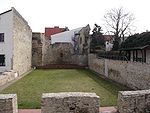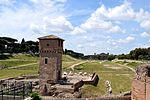Domus Augustana
Ancient palaces in RomePalatine Hill

The Domus Augustana is the modern name given to the central residential part of the vast Roman Palace of Domitian (92 AD) on the Palatine Hill. In antiquity the name may have applied to the whole of the palace.Its name is not directly related to the emperor Augustus (r. 27 BC – AD 14) and should not be confused with the nearby Domus Augusti, but probably refers to the later Roman meaning of Augustus as "emperor".
Excerpt from the Wikipedia article Domus Augustana (License: CC BY-SA 3.0, Authors, Images).Domus Augustana
Via di San Teodoro, Rome Municipio Roma I
Geographical coordinates (GPS) Address Nearby Places Show on map
Geographical coordinates (GPS)
| Latitude | Longitude |
|---|---|
| N 41.8877 ° | E 12.4866 ° |
Address
Palatino
Via di San Teodoro
00184 Rome, Municipio Roma I
Lazio, Italy
Open on Google Maps








